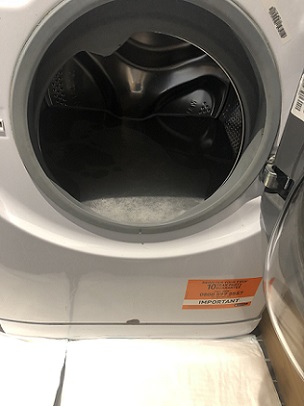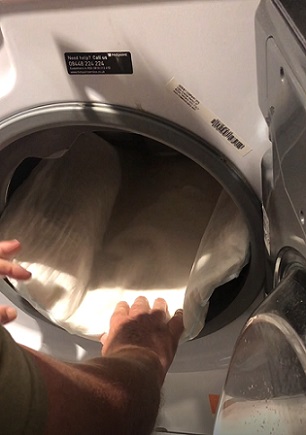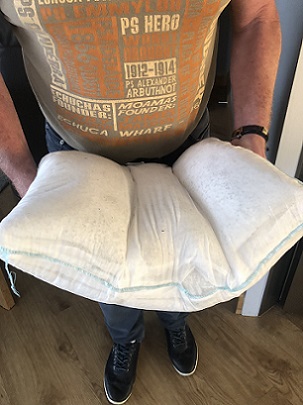 Faulty washing machine full of water with FloodSax alternative sandbags protecting the floor
Faulty washing machine full of water with FloodSax alternative sandbags protecting the floor
 Popping a FloodSax into the washing machine to soak up all the water
Popping a FloodSax into the washing machine to soak up all the water
 Here is the FloodSax once it's full of water
Here is the FloodSax once it's full of water
How to empty a faulty washing machine which is full of water
Every home and business is under a constant threat of spills, leaks and floods with many happening in the most annoyingly hard-to-reach places.
Water pipes run below floorboards, boilers can have a small space beneath them and it’s usually a tight squeeze to deal with drips and leaks under a sink. A broken valve or a worn washer on a tap can lead to water quickly causing colossal damage.
Then the so-called ‘white goods’ can go faulty such as fridge, freezer, washing machine or dishwasher.
So what do you do before a plumber can get there after disaster strikes? You’ll never manage to get a bucket under many of these leaks and a towel would quickly become sodden, adding to all the wet mess.
Many people – including plumbers – now use super-absorbent and flexible FloodSax. Their traditional role is as alternative sandbags. They resemble large pillowcases – ultra-thin with a large flat surface – but once immersed in water they absorb 20 litres which they retain in a special gelling polymer and inflate to become instant sandbags … but without the sand.
They can then be made into barriers to keep floodwater out of homes and businesses.
But in their dry state their super-absorbency, large surface area and thinness means they can be slipped under leaking pipes in the toughest-to-reach places and have saved people from the misery and cost of internal floods time and time again.
A couple in Huddersfield, West Yorkshire, recently discovered their washing machine had jammed on a cycle with water still in the drum. Instead of trying to scoop the water out which would have caused it to drip all over the place, they put a couple of dry FloodSax inside. They absorbed and soaked up all the water leaving no mess at all.
FloodSax have been used to deal with potentially damaging leaks from radiators, water pipes, boiler valves, sinks and even baths and showers.
Their large surface area means drips and leaks can fall onto the material which then absorbs it, stopping it from leaking any further.
Facilities managers use them in commercial buildings to deal with leaking roofs, pipes and radiators and many plumbers now carry them as an essential part of their kit.
Also think of them as an early warning system for drips and leaks that could worsen to become a major flooding problem causing potentially tens of thousands of pounds damage. If you suspect a leak or drip then pop a FloodSax underneath it and leave it for a day or two.
They are white so if there is a slight leak the tell-tale signs of a watermark on the FloodSax or the FloodSax itself slightly rising would indicate there is a problem that needs sorting.
This helped a plumber stop thousands of pounds damage at a West Yorkshire house he was working on. Plumber James Lucks was called to a house where a toilet was leaking from a corroded old lead pipe. He put FloodSax around the toilet and across the bathroom floor just in case the leak worsened … and it did in a massive way.
For the seal suddenly gave way, sending gallons of water gushing across the bathroom floor.
James said: “The FloodSax not only saved the day but the customer an awful lot of money in damage. The FloodSax soaked the water up which meant it didn’t penetrate the floor and leak through to the ceiling below. If the water had gone straight onto the floor it would have been a ceiling breaker for sure.”
When it comes to protecting homes, Christine Butler from Gloucestershire has ‘flood-proofed’ her flat with FloodSax after a leak from a neighbouring flat badly damaged her ceiling. She has slipped FloodSax beneath anywhere there are pipes or appliances that could cause a leak such as the bath, boiler and under the kitchen sink.
Christine said: “I’ve popped a FloodSax under any place in the flat where there could be a potential leak in the future. Once you have a leak which causes damage it’s such a hassle sorting out all the insurance which is why it’s best to prevent it in the first place.
“It also means that if water leaked into my flat from neighbouring flats the FloodSax would soak it up and minimise the damage.”
* If you have used FloodSax inside your home or business then please let us know what you used them for and how well they worked for you. Email andy@edslimited.co.uk